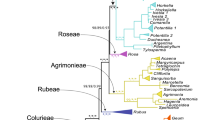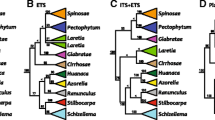Abstract
Generic relationships in the Pyrinae (equivalent to subfamily Maloideae) were assessed with six chloroplast regions and five nuclear regions. We also plotted 12 non-molecular characters onto molecular phylogenies. Chloroplast DNA trees are incongruent with those from nuclear regions, as are most nuclear regions with one another. Some of this conflict may be the result of hybridization, which occurs between many genera of Pyrinae in the present and may have occurred in the past, and duplication of nuclear loci. Sequence divergence between genera of Pyrinae, which is significantly less than that between genera of another large clade in Rosaceae, the Rosoideae, is concentrated in terminal branches, with short internal branches. This pattern is consistent with an ancient, rapid radiation, which has also been hypothesized from the fossil record. Even with about 500,000 bp of sequence, our results resolve only several small groups of genera and leave much uncertainty about phylogenetic relationships within Pyrinae.
Similar content being viewed by others
References
Aldasoro J. J., Aedo C. and Navarro C. (2005). Phylogenetic and phytogeographical relationships in Maloideae (Rosaceae) based on morphological and anatomical characters. Blumea 50: 3–15
Campbell C. S., Baldwin B. G., Donoghue M. J. and Wojciechowski M. F. (1995). A phylogeny of the genera of Maloideae (Rosaceae): Evidence from Internal Transcribed Spacers of nuclear ribosomal DNA sequences and congruence with morphology. Amer. J. Bot. 82: 903–918
Challice J. (1973). Phenolic compounds of the subfamily Pomoideae: A chemotaxonomic survey. Phytochemistry 12: 1095–1101
Challice J. S. (1974). Rosaceae chemotaxonomy and the origins of the Pomoideae. Bot. J. Linn. Soc. 69: 239–259
Challice J. and Kovanda M. (1978). Flavonoids as markers of taxonomic relationships in the genus Sorbus in Europe. Preslia 50: 305–320
Chevreau E., Lespinasse Y. and Gallet M. (1985). Inheritance of pollen enzymes and polyploid origin of apple (Malus x domestica Borkh.). Theor. Appl. Genet. 71: 268–277
Donoghue M. J. and Sanderson M. J. (1992). The suitability of molecular and morphological evidence in reconstructing plant phylogeny. In: Soltis, D. E., Soltis, P. S. and Doyle, J. J. (eds) Molecular systematics of plants, pp 340–368. Chapman and Hall, New York
Doyle J. J. and Doyle J. L. (1987). A rapid DNA isolation procedure for small quantities of fresh leaf tissue. Phytochem. Bull. 19: 11–15
Evans R. C. (1999) Molecular, morphological, and ontogenetic evaluation of relationships and evolution in Rosaceae. Ph.D. thesis, Botany Department, University of Toronto.
Evans R. C., Alice L. A., Campbell C. S., Kellogg E. A. and Dickinson T. A. (2000). The granule-bound starch synthase (GBSSI) gene in Rosaceae: multiple putative loci and phylogenetic utility. Molec. Phylogenet. Evol. 17: 388–400
Evans R. C. and Campbell C. S. (2002). The origin of the apple subfamily (Rosaceae: Maloideae) is clarified by DNA sequence data from duplicated GBSSI Genes. Amer. J. Bot. 89: 1478–1484
Evans R. C. and Dickinson T. A. (1999). Floral ontogeny and morphology in subfamily Spiraeoideae Endl. (Rosaceae). Int. J. Pl. Sci. 160: 981–1012
Evans R. C. and Dickinson T. A. (2005). Floral ontogeny and morphology in Gillenia (``Spiraeoideae'') and subfamily Maloideae C. Weber (Rosaceae). Int. J. Pl. Sci. 166: 427–447
Farr D. F. (1989). Fungi on plants and plant products in the United States. APS Press, St. Paul, Minn
Farr D. F., Rossman A. Y., Palm M. E., McCray E. B. (2005) Fungal databases, Systematic Botany & Mycology Laboratory. Agricultural Research Service, United States Dept. of Agriculture.
Felsenstein J. (1978). Cases in which parsimony and compatibility methods will be positively misleading. Syst. Zool. 27: 401–410
Felsenstein J. (1985). Confidence limits on phylogenies: An approach using the bootstrap. Evolution 39: 783–791
Fiala K. I. and Sokal R. R. (1985). Factors determining the accuracy of cladogram estimation: evaluation using computer simulation. Evolution 39: 609–622
Fishbein M., Hibsch-Jetter C., Soltis D. E. and Hufford L. (2001). Phylogeny of Saxifragales (angiosperms, eudicots): analysis of a rapid, ancient radiation. Syst. Biol. 50: 817–847
Fishbein M. and Soltis D. E. (2004). Further resolution of the rapid radiation in Saxifragales (angiosperms, eudicots) supported by mixed-model Bayesian analysis. Syst. Bot. 29: 883–891
Godron D. A. (1874). De l'hybridité dans le genre Sorbier. Rev. Sci. Nat. 4: 443–447
Graham S. (1997) Phylogenetic analyses of breeding-system evolution in heterostylous monocotyledons. Ph.D. thesis, Botany Department, University of Toronto.
Hasegawa M., Kishino H. and Yano T. (1985). Dating of the human-ape split by a molecular clock of mitochondrial DNA. J. Molec. Evol. 21: 160–174
Huelsenbeck J. P. (1995). Performance of phylogenetic methods in simulation. Syst. Biol. 44: 17–48
Hutchinson J. (1964). The genera of flowering plants, vol. 1, Dicotyledons. Clarendon Press, Oxford
Ishikawa S., Kato S., Imakawa S., Mikami T. and Shimamoto Y. (1992). Organelle DNA polymorphisms in cultivated apple and rootstocks. Theor. Appl. Genet. 83: 963–967
Jones G. N. (1946). American species of Amelanchier. Urbana, Illinois
Kalkman C. (1973). The Malesian species of the subfamily Maloideae (Rosaceae). Blumea 21: 413–442
Kalkman C. (2004). Rosaceae. In: Kubitzki, K. (eds) The families and genera of vascular plants, pp 343–386. Springer, Berlin
Kovanda M. (1965). On the generic limits in the Maloideae. Preslia 37: 27–34
Liljefors A. (1934). Űber normale und apospore Embryosackentwicklung in der Gattung Sorbus, nebst einigen Bemerkungen űber die Chromosomenzahlen. Svensk Bot. Tidskr. 28: 290–299
Liljefors A. (1953). Studies on propagation, embryology and pollination in Sorbus. Acta Horti Berg. 16: 277–329
Linder C. R. and Rieseberg L. H. (2004). Reconstructing patterns of reticulate evolution in plants. Amer. J. Bot. 91: 1700–1708
Lo E., Stefanovic S., Dickinson T. A., in press. Crataegus and Mespilus (Pyreae, Rosaceae) – two genera or one? Syst. Bot.
McDade L. A. (1995). Hybridization and phylogenetics. In: Hoch, P. C. and Stephenson, A. G. (eds) Experimental and molecular approaches to plant biosystematics, pp 305–331. Missouri Botanical Garden, St. Louis
Morgan D. R., Soltis D. E. and Robertson K. R. (1994). Systematic and evolutionary implications of rbcL sequence variation in Rosaceae. Amer. J. Bot. 81: 890–903
Nelson-Jones E. B., Briggs D. and Smith A. G. (2002). The origin of intermediate species of the genus Sorbus. Theor. Appl. Genet. 105: 953–963
Oddou-Muratorio S., Petit R. J., Guerroue B. L., Guesnet D. and Demesure B. (2001). Pollen- versus seed-mediated gene flow in a scattered forest tree species. Evolution 55: 1123–1135
Petit R. J., Pineau E., Demesure B., Bacillieri R., Ducousso A., Kremer A. (1997) Chloroplast DNA footprints of postglacial recolonization by oaks. Proc. Natl. Acad. Sci. USA 94.
Phipps J. B., Robertson K. R., Rohrer J. R. and Smith P. G. (1991). Origins and evolution of subfamily Maloideae (Rosaceae). Syst. Bot. 16: 303–332
Posada D. and Crandall K. A. (1998). Modeltest: testing the model of DNA substitution. Bioinformatics 14: 817–818
Potter D., Eriksson T., Evans R. C., Oh S.-H., Smedmark J., Morgan D., Kerr M., Robertson K. R., Arsenault M., Dickinson T. A., Campbell C. S., In press. Phylogeny and classification of Rosaceae. Pl. Syst. Evol. 266: 5–43.
Rambaut A. (2002). Se-Al: sequence alignment editor. University of Oxford, Oxford, England
Raspé O. A., Jacquemart L. and De Sloover J. (1998). Isozymes in Sorbus aucuparia (Rosaceae: Maloideae): genetic analysis and evolutionary significance of zymograms. Int. J. Pl. Sci. 159: 627–636
Raspé O. and Kohn J. R. (2002). S-allele diversity in Sorbus aucuparia and Crataegus monogyna (Rosaceae: Maloideae). Heredity 88: 458–465
Rieseberg L. H. and Soltis D. E. (1991). Phylogenetic consequences of cytoplasmic gene flow in plants. Evol. Trends Pl. 5: 65–84
Robertson K. R., Phipps J. B., Rohrer J. R. and Smith P. G. (1991). A synopsis of genera of the Maloideae (Rosaceae). Syst. Bot. 16: 376–394
Roemer M. J. (1847) Familiarum naturalium regni vegetabilis synopses monographicae. III. Rosi-florae. Amygdalacearum et Pomacearum. Weimar, Landes-Industrie-Comptoir.
Rohrer J. R., Robertson K. R. and Phipps J. B. (1991). Variation in structure among fruits of Maloideae (Rosaceae). Amer. J. Bot. 78: 1617–1635
Rohrer J. R., Robertson K. R. and Phipps J. B. (1994). Floral morphology of Maloideae (Rosaceae) and its systematic relevance. Amer. J. Bot. 81: 574–581
Rokas A., Kruger D. and Carroll S. B. (2005). Animal evolution and molecular signature of radiation compressed in time. Science 310: 1933–1938
Ronquist F. and Huelsenbeck J. P. (2003). MrBayes 3: Bayesian phylogenetic inference under mixed models. Bioinformatics 19: 1572–1574
Sang T. (2002). Utility of low-copy nuclear gene sequences in plant phylogenetics. Crit. Rev. Biochem. Molec. Biol. 37: 121–147
Savile D. B. O. (1979). Fungi as aids in higher plant classification. Bot. Rev. 45: 380–495
Sax K. (1931). The origin and relationships of the Pomoideae. J. Arnold Arbor. 12: 3–22
Sax K. (1932). Chromosome relationships in the Pomoideae. J. Arnold Arbor. 13: 363–367
Sax K. (1933). The origin of the Pomoideae. Proc. Amer. Soc. Hort. Sci. 30: 147–150
Simmmons M. P. and Ochoterena H. (2000). Gaps as characters in sequence-based phylogenetic analyses. Syst. Biol. 49: 369–381
Spjut R. W. (1994). A systematic treatment of fruit types. Bronx, New York
Sterling C. (1964). Comparative morphology of the carpel in the Rosaceae. III. Pomoideae: Crataegus, Hesperomeles, Mespilus, Osteomeles. Amer. J. Bot. 51: 705–712
Sterling C. (1965a). Comparative morphology of the carpel in the Rosaceae. IV. Pomoideae: Chamaemeles, Cotoneaster, Dichotomanthes, Pyracantha. Amer. J. Bot. 52: 47–54
Sterling C. (1965b). Comparative morphology of the carpel in the Rosaceae. V. Pomoideae: Amelanchier, Aronia, Malacomeles, Malus, Peraphyllum, Pyrus, Sorbus. Amer. J. Bot. 52: 418–426
Sterling C. (1965c). Comparative morphology of the carpel in the Rosaceae. VI. Pomoideae: Eriobotrya, Heteromeles, Photinia, Pourthiaea, Raphiolepis, Stranvaesia. Amer. J. Bot. 52: 938–946
Sterling C. (1966). Comparative morphology of the carpel in the Rosaceae. VII. Pomoideae: Chaenomeles, Cydonia, Docynia. Amer. J. Bot. 53: 225–231
Swofford D. L. (2001). PAUP*: Phylogenetic Analysis Using Parsimony. Sinauer Associates, Inc, Sunderland, MA
Talent N. and Dickinson T. A. (2005). Polyploidy in Crataegus and Mespilus (Rosaceae, Maloideae): evolutionary inferences from flow cytometry of nuclear DNA amounts. Canad. J. Bot. 83: 1268–1304
Vidal J. E. (1965). Notes sur quelques Rosacées Asiatique (II) (Photinia, Stranvaesia). Adansonia 5: 221–237
Weeden N. and Lamb R. (1987). Genetics and linkage analysis of 19 isozyne loci in apple. J. Amer. Hort. Soc. 112: 865–872
Wilson M. A., Grant B. and Clegg M. T. (1990). Chloroplast DNA evolves slowly in the palm family (Arecaceae). Molec. Biol. Evol. 7: 303–314
Wolfe J. A. and Wehr W. (1988). Rosaceous Chamaebatiaria-like foliage from the Paleogene of western North America. Aliso 12: 177–200
Yang Z. (1994a). Phylogenetic analysis using parsimony and likelihood methods. J. Molec. Evol. 39: 294–307
Yang Z. (1994b). Estimating the pattern of nucleotide substitution. Molec. Evol. 39: 105–111
Zhang L. Q., Pond S. K. and Gaut B. S. (2001). A survey of the molecular evolutionary dynamics of twenty-five multigene families from four grass taxa. J. Molec. Evol. 52: 144–156
Zhang S.-Y. (1992). Wood anatomy of the Rosaceae. Rijksherbarium/Hortus Botanicus, Leiden
Author information
Authors and Affiliations
Corresponding author
Rights and permissions
About this article
Cite this article
Campbell, C., Evans, R., Morgan, D. et al. Phylogeny of subtribe Pyrinae (formerly the Maloideae, Rosaceae): Limited resolution of a complex evolutionary history. Plant Syst. Evol. 266, 119–145 (2007). https://doi.org/10.1007/s00606-007-0545-y
Received:
Accepted:
Published:
Issue Date:
DOI: https://doi.org/10.1007/s00606-007-0545-y




